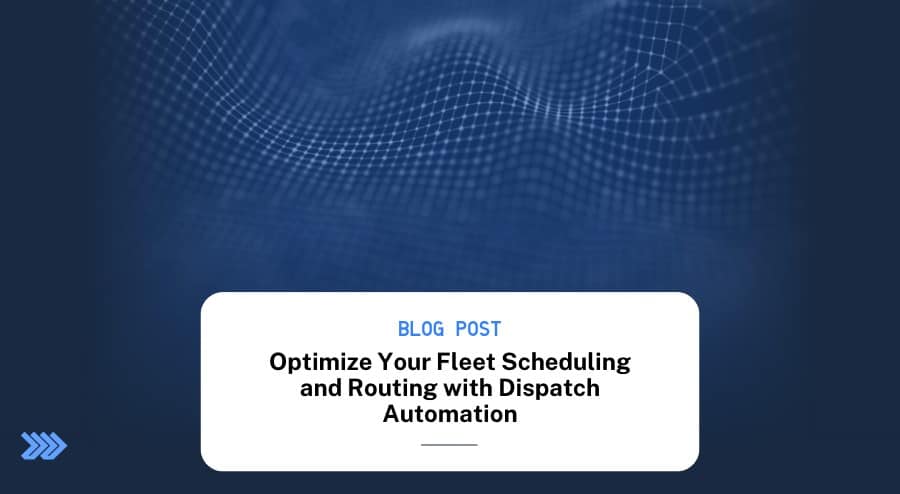Optimize Your Fleet Scheduling and Routing with Dispatch Automation

Wise Systems

Fleet dispatching is like a wedding. The better the planning, the more effortless it appears. But as any fleet manager (or wedding planner) worth their salt would tell you, it takes more than a “perfect” schedule to make the day go off without a hitch. You need to be flexible, seek out efficiencies, and use tools that can adapt in real-time to issues, like extra delivery orders or a long-winded Best Man.
Today, fleet managers and dispatchers can harness data to help them optimize three very important pieces of the puzzle when it comes to fleet management: fleet scheduling, routing, and dispatching.
In this post, we’ll define fleet scheduling, route planning, and dispatch automation and discuss their many business benefits. We’ll also show you how the right automated fleet route optimization software can drastically improve your delivery operations.
What Is Fleet Scheduling?
Fleet scheduling is determining when each driver or field operator should be at each location to ensure deliveries (or pickups) are made within customer delivery windows.
For instance, a fleet manager or dispatcher might communicate a fleet schedule to two of their drivers, potentially via a vehicle dispatch system equipped with fleet dispatching software to get Bob (Zone A) and Jill (Zone B) to their respective stops. If the fleet is using a driver mobile app, the stop sequences will appear there. If it’s a legacy dispatching system, their routes may be shared via printed lists
But best-in-class fleet management encompasses more than just scheduling and getting drivers to the right stops at the right time. Fleet managers are also responsible for planning route paths that improve efficiency, customer experience and overall delivery operations.
What Is Route Planning?
Route planning and fleet scheduling go hand-in-hand. Simply put, route planning is ensuring the most efficient route paths between stops scheduled for each driver while taking into account customer and business expectations and physical constraints. Expectations and constraints include the fleet schedule, geographic zones, vehicle capacity, weight limits, predicted traffic, driver constraints and other operational requirements.
Effective route planning requires large amounts of information from a variety of sources to ensure these expectations and constraints are input.
Benefits of Route Planning
A well-planned and continuously optimized route can result in:
- Improved efficiency and productivity
- Reduced fuel costs and emissions
- Enhanced customer satisfaction
- Increased profitability
- Better driver performance and satisfaction
Excellent daily route planning can improve the experience for everyone on your staff and for your customers. It can also directly impact profit margins.
What if I need to change a route mid-execution?
In today’s delivery environment orders and pickups are often added by customers after routes have been dispatched, requiring the fleet schedule to be changed during execution — a nightmare if using printed stop lists.
Over the past decade, new technologies have enabled dispatchers to send these stops to a chosen driver and update the driver’s stop schedule while informing the driver of the change via an integrated driver app. Modern, cloud-based dispatch automation systems take this a step further.
What Is Dispatch Automation and How Does It Help?
Dispatch automation helps reschedule your fleet when new orders come in during route execution while keeping routes as efficient as possible. It would be nearly impossible to manually track, manage and accommodate all of the necessary data points to schedule efficiently for a large fleet, let alone manually create and communicate updated routes to a team of drivers.
Informed by advanced algorithms, the best dispatch automation software fills that gap, automatically receiving new orders then determining the optimal driver based on key parameters/constraints.
The system can then automatically add the order to the driver’s schedule and update the driver and dispatcher via app, or notify the dispatcher of the driver selection. In the latter case, the dispatcher then approves the change so the system can add the order to the driver’s schedule and update the driver via driver app.
How Dispatch Automation Helps
- Automates high-volume tasks – Leverages massive computing power and algorithms to automate route adjustments while supporting your fleet goals (e.g., maximizing fleet utilization, increasing on-time delivery, reducing fleet miles)
- Collects & aggregates fleet data — Automatically collects data on vehicle locations, routes, schedules and more for faster decision making during route execution and more accurate route planning in the future.
- Adjusts routes using fleet and other data sources – Makes route-schedule adjustments using multiple data sources.
- Allows for review – Allows dispatchers to preview and adjust route changes before committing.
Wise Systems | Powerful Delivery Route Optimization Software
See how your fleet can use Route Planner to automatically plan the most effective fleet schedules while factoring in your operation’s unique variables and constraints. Then check out Dispatcher and our other integrated solutions to see how you can more quickly adjust routes in real time during route execution.
Use the form below to schedule a demo or touch base with us to learn more.





